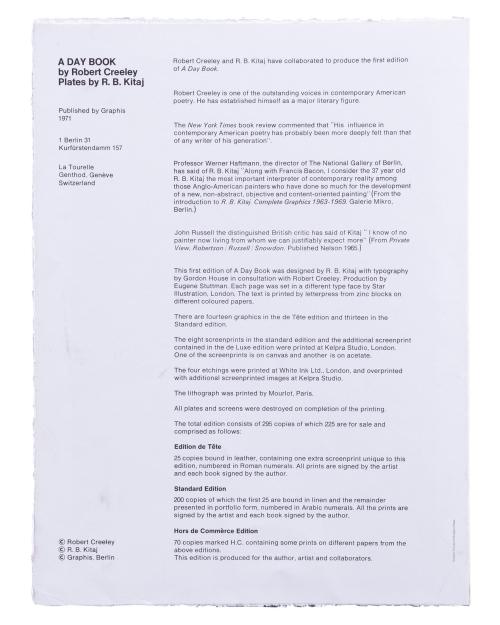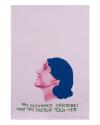A Day Book
Artist: Ronald B. Kitaj (American, 1932 - 2007)
Publisher: Graphis, Berlin, 1972
Printer: screen prints: Kelpra Studio, London; etchings: White Ink Ltd., London; overprinted with screen printing by Kelpra Studio; lithogr
Binder: Rudolf Rieser, assisted by Helmut Klohs, [s.l.]
Author: Robert Creeley (American, born 1926)
Date: 1972
Medium: Original prints: 10 screenprints in colors (incl. 7on variously colored laid papers, 1 on canvas, 1 on blue acetate, the title page, and wrappers); 4 etchings in black, brown or blind on white wove paper with added screenprinting in colors; 1 lithograph on Arches white wove paper.
Text: letterpress from zinc blocks on wove paper in various colors
Classification: Books
Credit Line: Gift of Molly and Walter Bareiss
Object number: 1984.610
Label Text:R. B. Kitaj, A Day Book. Text by Robert Creeley (1972)
Robert Creeley dropped out of Harvard in the 1940s, founded Divers Press to publish contemporary poetry, and taught at Black Mountain College in North Carolina. He was editor of the influential literary journal, Black Mountain Review. He published several dozen poetry books, a collection of stories, a novel, and two collections of experimental prose. Ronald Brooks Kitaj was born in Cleveland and studied at the Royal College of Art, London. He has been linked to the Pop Art movement of the 1960s. The two met at a poetry reading in London in the 1960s. Kitaj considered Creeley’s poetry a turning point in his understanding of letters—symbols he frequently introduces into his prints and paintings.
For A Day Book, Kitaj asked Creeley to provide a text that would be the basis for a sequence of prints. Creeley wanted it to be “long enough” and hit upon the number thirty. So A Day Book is precisely what it says it is: 30 pages of writing done over 30 days. Creely describes it as “a literal record of the day’s activities and thoughts, without attempt to understand or digest or to reflect upon them.” Each text page is printed on a different color with a different typeface, a strategy suited to the arbitrary time structure. Kitaj then chose individual lines from several of the pages, which became intrinsic parts of his images.
Robert Creeley dropped out of Harvard in the 1940s, founded Divers Press to publish contemporary poetry, and taught at Black Mountain College in North Carolina. He was editor of the influential literary journal, Black Mountain Review. He published several dozen poetry books, a collection of stories, a novel, and two collections of experimental prose. Ronald Brooks Kitaj was born in Cleveland and studied at the Royal College of Art, London. He has been linked to the Pop Art movement of the 1960s. The two met at a poetry reading in London in the 1960s. Kitaj considered Creeley’s poetry a turning point in his understanding of letters—symbols he frequently introduces into his prints and paintings.
For A Day Book, Kitaj asked Creeley to provide a text that would be the basis for a sequence of prints. Creeley wanted it to be “long enough” and hit upon the number thirty. So A Day Book is precisely what it says it is: 30 pages of writing done over 30 days. Creely describes it as “a literal record of the day’s activities and thoughts, without attempt to understand or digest or to reflect upon them.” Each text page is printed on a different color with a different typeface, a strategy suited to the arbitrary time structure. Kitaj then chose individual lines from several of the pages, which became intrinsic parts of his images.
Not on view
In Collection(s)



















